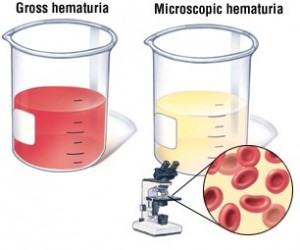Haematuria
Haematuria is defined as the presence of blood in the urine. When the bleeding is visible or can be seen by the naked eye it is termed frank haematuria or macroscopic haematuria. The urine may be pink, red or brownish in colour due to the blood present in it.
 |
|
However, most often it is only present in very small amounts and is invisible to the naked eye and hence termed microscopic haematuria. A simple test of the urine can detect these very small quantities of blood. Many times, one is found to have blood in the urine incidentally or when having a routine medical examination.
|
Microscopic haematuria is usually detected by using a simple urine dipstick test. This test is sensitive, convenient, cheap and widely available. It requires a sample of urine, preferably an early morning specimen, and a small plastic strip with an indicator attached to it. The change of the colour on the strip will signify that you have blood in the urine. A repeat examination is required to confirm this finding. Occasionally, a urine sample is required to be sent to the laboratory as well. It is usual to test the urine at the same time for the presence of protein (see Section “What is Proteinuria?”)
Common causes of haematuria include urinary tract infection, urinary tract stones, bladder or prostate tumours, inflammation in the kidneys or lower urinary tract. The commonest cause of haematuria is urinary tract infection. Symptoms such as a burning pain during urination, lower abdominal pain, frequency of urination, fever and a poor appetite may suggest a urinary tract infection. It is advisable to see a doctor. A urine sample will be sent to the laboratory to confirm the infection and identify the responsible bacteria.as well as the antibiotics to which it will respond.
When there are no symptoms to suggest a urinary tract infection and the blood in the urine is visible by the naked eye, you should see a urologist. This is particularly necessary for individuals more than 65 years of age. Such individuals are at a higher risk of developing a lower genito-urinary tract cancer and further evaluation is required.
Initial investigations for haematuria should include measurement of your blood pressure and blood tests to determine the function of your kidneys. Other investigations may include a full blood count to look for anaemia, infection or low platelet counts and tests of blood clotting.
In younger patients or patients that have both haematuria and proteinuria, referral to a nephrologist is warranted. Imaging procedures such as the ultrasound, CT scan or an intravenous pyelogram may be warranted. Finally, a renal biopsy, which is taking a tiny sample of your kidney, may need to be done to determine the cause of the kidney disease (see section on “Specific Tests”)
Source:
Diagram 1: http://bladdersymptoms.net/images/gross_hematuria.jpg
Diagram 2: http://www.drugs.com/health-guide/images/204995.jpg
| Last Reviewed | : | 3 May 2016 |
| Writer | : | Dr. Anita Bhajan Manocha |
| Accreditor | : | Dr. Sunita Bavanandan |
 PENDIDIKAN PESAKIT Kementerian Kesihatan Malaysia
PENDIDIKAN PESAKIT Kementerian Kesihatan Malaysia



